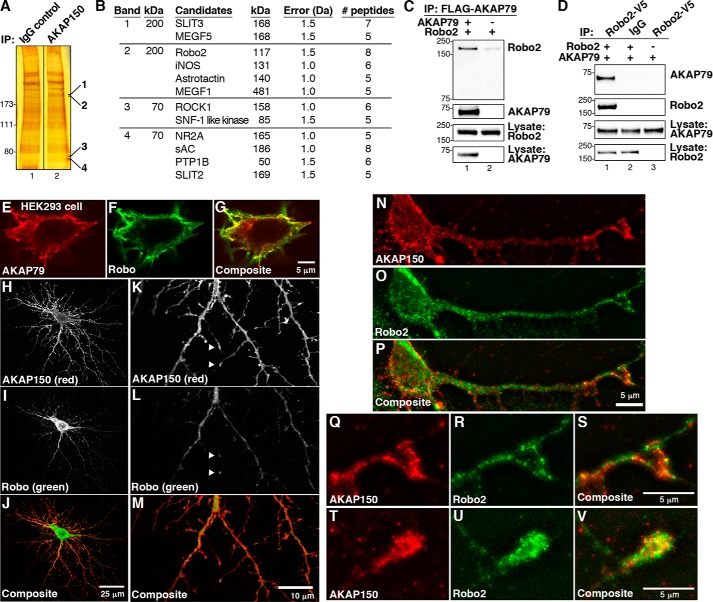FIGURE 1.
AKAP79/150 interacts with Robo2. A, mass spectrometry screening to identify AKAP150 binding proteins. Immune complex complexes were isolated from mouse brain lysates. Silver-stained SDS-polyacrylamide gels of control (lane 1) and AKAP150 (lane 2) immune complexes are shown. Molecular weight markers are indicated. Bands present in AKAP150 immunoprecipitations (IP) were excised (the bands shown), and protein determination was by MALDI-TOF mass spectrometry. B, table of proteins identified in AKAP150 complexes. Columns indicate the name, molecular weight, mass error, number of peptides detected, and percentage coverage of each protein. C and D, validation of AKAP150 association with Robo2. HEK293 cells were transfected with FLAG-AKAP79 and V5-Robo2. FLAG immune complexes were immunoblotted for Robo2 (top) and AKAP79 (top middle). Loading controls for Robo2 (bottom middle) and AKAP79 (bottom) are included. D, reciprocal immunoprecipitation of Robo2 immune complexes blotted for AKAP79 (top) and Robo2 (top middle). E–G, confocal imaging of AKAP79 (E and G, red) and Robo (F and G, green) in HEK293 cells. H–P, DIV 15 mouse hippocampal neurons were transfected with Robo and immunostained for Robo and endogenous AKAP150. The staining patterns of AKAP150 (H and K (grayscale) and J and M (red)) and Robo (I and L (grayscale) and J and M (green)) were assessed by confocal microscopy. Details of the dendritic arbor are shown at higher magnification, and co-distribution of AKAP150 and Robo at tips of neuronal processes is indicated with arrows (K–M). N–P, neonatal mouse hippocampal neurons cultured for 4 DIV were stained for endogenous AKAP150 (N and P, red) and endogenous Robo2 (O and P, green). The staining patterns of both proteins were assessed by digital deconvolution microscopy. Q–V, higher magnification images of dendritic processes showing co-clustering (yellow) of AKAP150 (Q, S, T, and V; red) and Robo2 (R, S, U, and V; green) in putative growth cones.

